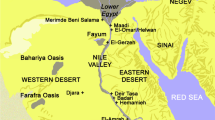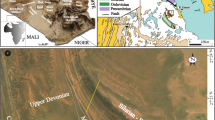Abstract
The origins of modern man are a subject of controversy among palaeoanthropologists concerned with human evolution1–3. Particularly heavily debated is the dating of hominid remains uncovered in southwestern Asia, because middle palaeolithic sites have provided skeletal remains classified as representing Neanderthals (Homo sapiens neanderthalensis at Tabun, Amud, Kebara and Shanidar caves) and proto-Cro-Magnons (Homo sapiens sapiens at Skhul and Qafzeh caves). This situation differs considerably from that of Western Europe, where only Neanderthal remains are known from archaeological deposits of this period, or that of the African continent, where no Neanderthal remains have so far been found. Two opposing hypotheses have been offered to explain the relations between Neanderthals and the earliest modern Homo sapiens: first that modern Homo sapiens appeared very early in the Mediterranean Levant and coexisted with a population of Neanderthals who had arrived at a later date; and second that modern humans developed from the local Neanderthal population in southwestern Asia. Recent excavations at the Kebara cave yielded Neanderthal burial in a well-documented stratigraphic and cultural Mousterian sequence4,5. We now report that ther-moluminescence dates from 38 specimens of burnt flint recovered from 4 m of Kebara deposits range from about 60,000 to 48,000 years before present (BP), indicating that Neanderthals were present in the Levant in the latter part of the middle Palaeolithic.
Similar content being viewed by others
References
1. Vandermeersch, B. Les hommes fossiles de Qafzeh, Israel (CNRS, Paris, 1981). 2. Trinkaus, E. in The Origins of Modern Humans (eds Smith, F. H. & Spencer, F.) 251-293 (Liff, New York, 1984). 3. Wolpoff, M. H., Smith, H. F., Malez, M., Radovcic, J. & Rukavina, D. Am. J. Phys. Anthrop. 54,499-545 (1981). 4. Bar-Yosef, O. et al. Curr. Anthrop. 27, 63-64 (1986). 5. Arenburg, B. et al. C. r. hebd. Seanc. Acad. Sci, Pans 300, 227-230 (1985). 6. Farrand, W. R. J. archaeol. Sci 6, 369-392 (1979). 7. Salanville, P. in Prehistoire du Levant (eds Cauvin, J. & Salanville, P.) 21-32 (CNRS, Paris, 1981). 8. Jelinek, A. J. in Prehistoire du Levant (eds Cauvin, J. & Salanville, P.) 265-280 (CNRS, Paris, 1981). 9. Jelinek, A. J. Science 216, 4553, 1369-1375 (1982). 10. Bar-Yosef, O. & Vandermeersch, B. in Prehistoire du Levant (eds Cauvin, J. & Salanville, P.) 281-286 (CNRS, Paris, 1981). 11. Tchernov, E. in Quaternary Extinctions (eds Martin, P. S. & Klein, R. G.) 528-552 (University of Arizona Press, Tucson, 1984). 12. Huxtable, J. & Jacobi, R. M. Archaeometry 24, 164-169 (1982). 13. Bowman, S. G. E. & Sieveking, G. de G. Pact 9, 353-361 (1982). 14. Aitken, M. J. Thermoluminescence Dating (Academic, New York, 1985). 15. Valladas, H. thesis, Univ. Paris VI (1985). 16. Valladas, H., Geneste, J. M., Joron, J. L. & Chadelle, J. P. Nature 322, 452-454 (1986). 17. Valladas, H. & Valladas, G. Archaeometry 27, 214-220 (1987). 18. Chayla, B., Jaffrezic, H. & Joron, J. L. C. r. hebd, seanc. Acad. Sci., Paris 277,273-275 (1973). 19. Shackleton, N. J. & Opdyke, N. D. Quat, Res. 3, 39-55, (1973). 20. Vandermeersch, B. in The Transition from the Lower to the Middle Palaeolithic and the Origin of Modern Man (ed. Ronen, A.) 297-300 (BAR, Oxford, 1982). 21. Bar-Yosef, O. in Corridors, Cul-de-Sac and Coalescence: the Bio-cultural Foundations of Modern People (ed. Trinkaus, E.) (Cambridge University Press, in the press). 22. Valladas, H. & Valladas, G. Pact 6, 171-178 (1982). 23. Aitken, M. J. & Bowman, S. G. E. Archaeometry 17, 132-138 (1975). 24. Bell. W. T. Archaeometry 21, 243-245 (1979). 25. Kvasnicka, J. Hlth Phys. 36, 521-524 (1979). 26. Prescott, J. R. & Stephan, L. G. Pact 6, 17-25 (1982). 27. Aitken, M. J. Archaeometry 18, 233-238 (1976). 28. Gvirtzman, G. Annual Meeting of the Israel Society for Quaternary Research, 14-20 (University of Jerusalem, 1983).
Author information
Authors and Affiliations
Rights and permissions
About this article
Cite this article
Valladas, H., Joron, J., Valladas, G. et al. Thermoluminescence dates for the Neanderthal burial site at Kebara in Israel. Nature 330, 159–160 (1987). https://doi.org/10.1038/330159a0
Received:
Accepted:
Issue Date:
DOI: https://doi.org/10.1038/330159a0
- Springer Nature Limited
This article is cited by
-
3D shape analyses of extant primate and fossil hominin vertebrae support the ancestral shape hypothesis for intervertebral disc herniation
BMC Evolutionary Biology (2019)
-
The age of the hominin fossils from Jebel Irhoud, Morocco, and the origins of the Middle Stone Age
Nature (2017)
-
Le Levant méditerranéen et les nomades moustériens : un territoire de confluence
Bulletins et Mémoires de la Société d'Anthropologie de Paris (2017)





